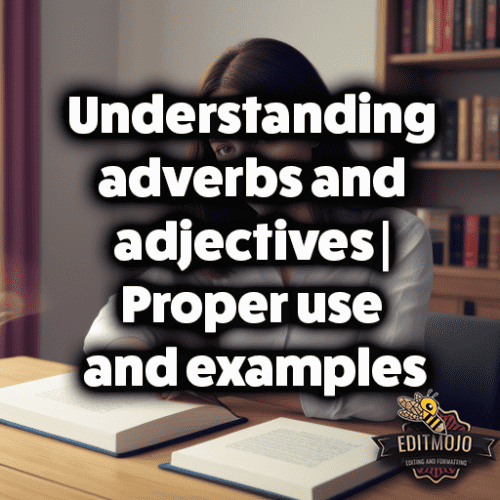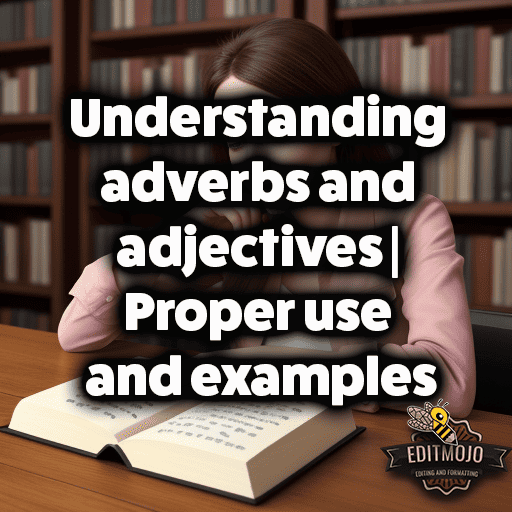Understanding adverbs and adjectives | Proper use and examples
Understanding adverbs and adjectives | Proper use and examples. Welcome to the fascinating world of English grammar, a labyrinth of rules, exceptions, and surprises. Our exploration today leads us into two of the most crucial components: adverbs and adjectives. These parts of speech add the much-needed flavor to our expressions and are indispensable in painting vivid pictures with words. This article seeks to demystify these two grammatical powerhouses and provide a better understanding of their usage. Let’s dive in!
Key Takeaways
| Key Points | Description |
|---|---|
| Adjectives | These are words that modify or describe nouns and pronouns, adding more detail. |
| Adjective Placement | Adjectives typically come before the noun they modify, but they can also follow the noun, usually after a linking verb. |
| Adverbs | These are words that modify verbs, adjectives, and other adverbs, often answering questions like how, when, where, why, or to what extent. |
| Adverb Placement | Adverb placement varies, but if it modifies a verb, it generally follows the verb. |
| Practical Application | The proper and strategic use of adverbs and adjectives enhances descriptive language, making your writing and speech more engaging and expressive. |
Unpacking Adjectives (grammar)
Definition and Function of Adjectives
So, what are adjectives? In the simplest terms, adjectives are ‘describing words’. They serve to modify or describe nouns and pronouns in a sentence. They can tell us which one, what kind, or how many, giving more detail about the noun or pronoun.
For example, consider the sentence: “I saw a beautiful, ancient structure on my vacation.” Here, “beautiful” and “ancient” are adjectives describing the noun “structure.”

Proper Use of Adjectives
It’s essential to know where to place adjectives in a sentence. Typically, they come before the noun they modify. However, they can also follow the noun, usually after a linking verb. For example, “John is happy.”
Comparative and superlative forms of adjectives allow us to compare different nouns. For example, “John is taller than Jim.” Here, “taller” is the comparative adjective. The superlative form would be, “John is the tallest person in the room.”
Common Mistakes with Adjectives
One common mistake is the overuse of adjectives or using them redundantly. Remember, less is often more when it comes to adjectives. For instance, saying a “delicious, tasty, yummy cake” is redundant as all three adjectives essentially mean the same thing.
Examples of Adjectives in Sentences
“Her red hair gleamed in the sunlight.” (Color Adjective)
“Six dogs were playing in the park.” (Number Adjective)
“The cake was incredibly sweet.” (Opinion Adjective)
Exploring Adverbs
Definition and Function of Adverbs
Adverbs, like adjectives, are descriptive words. However, they modify verbs, adjectives, and even other adverbs. They often answer the questions how, when, where, why, or to what extent.
For instance, in the sentence, “She runs quickly,” “quickly” is an adverb that describes how she runs.
Proper Use of Adverbs
Adverb placement varies and largely depends on what the adverb is modifying. For example, if it modifies a verb, it generally follows the verb: “She speaks softly.”
Just like adjectives, adverbs also have comparative and superlative forms. For example, “He runs faster than me,” and “He runs the fastest in his team.”

Common Mistakes with Adverbs
A common mistake is using adjectives instead of adverbs, especially with the verb “feel.” For example, “I feel bad” is correct, while “I feel badly” suggests you are poor at feeling, which is likely not the intended meaning.
Examples of Adverbs in Sentences
“He walked slowly towards the door.” (Manner Adverb)
“She will leave tomorrow.” (Time Adverb)
“The dog is hiding underneath the bed.” (Place Adverb)
Comparing Adverbs and Adjectives
While both adverbs and adjectives add detail and richness to our language, their roles are distinct. While adjectives modify nouns and pronouns, adverbs modify verbs, adjectives, and other adverbs.
A classic example of adverb-adjective confusion is the difference between “good” and “well.” “Good” is an adjective, so you should say, “She is a good singer.” “Well” is an adverb, so you would say, “She sings well.”
Practical Application
The judicious use of adverbs and adjectives enhances descriptive language, making your writing more engaging and expressive. By painting a clear picture in the reader’s mind, you can transform your writing from mundane to mesmerizing.
Consider these two sentences:
- “I walked through the forest.”
- “I sauntered through the sprawling, tranquil forest, awed by its ancient majesty and enveloped by the sweet symphony of nature.”
The second sentence is undoubtedly more evocative, and that’s the magic of adverbs and adjectives!
Interactive Section (Understanding adverbs and adjectives | Proper use and examples)
Now that you’re more familiar with adverbs and adjectives, why not test your understanding? Try out this fun interactive quiz to test your knowledge and understanding.
Conclusion (Understanding adverbs and adjectives | Proper use and examples)
Adverbs and adjectives are key players in the language game. They lend depth, color, and emotion to our expressions. Understanding their functions and using them effectively can significantly enhance your communication skills. Remember, the English language is a beautiful garden, and adverbs and adjectives are some of its most vibrant flowers. So, don’t shy away from using them – but do so with care!
For those hungry for more knowledge, here’s a great resource for further reading. Now, go out there, and paint the world with your words!

Top Five Questions and Answers
| Questions | Answers |
|---|---|
| What are adjectives? | Adjectives are words that modify or describe nouns and pronouns. |
| What are adverbs? | Adverbs are words that modify verbs, adjectives, and other adverbs. |
| Where do we usually place adjectives in a sentence? | Adjectives usually come before the noun they modify, but can also follow the noun after a linking verb. |
| Where do we usually place adverbs in a sentence? | Adverb placement varies, but if it modifies a verb, it generally follows the verb. |
| How do adverbs and adjectives enhance language? | They add detail and richness to language, making writing and speech more engaging and expressive. |
